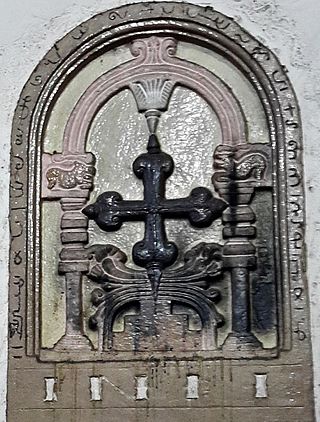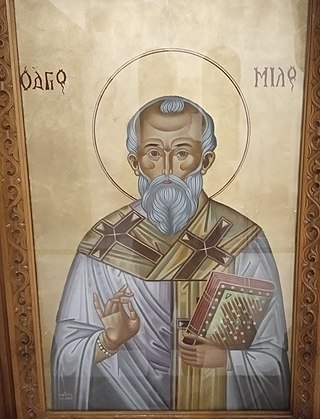
Year 414 (CDXIV) was a common year starting on Thursday of the Julian calendar. At the time, it was known as the Year of the Consulship of Constantius and Constans. The denomination 414 for this year has been used since the early medieval period, when the Anno Domini calendar era became the prevalent method in Europe for naming years

Yazdegerd II, was the Sasanian King of Kings of Iran from 438 to 457. He was the successor and son of Bahram V.

Yazdegerd I was the Sasanian King of Kings of Iran from 399 to 420. A son of Shapur III, he succeeded his brother Bahram IV after the latter's assassination.

Yazdegerd III was the last Sasanian King of Kings of Iran from 632 to 651. His father was Shahriyar and his grandfather was Khosrow II.

Bahram V, also known as Bahram Gur, was the Sasanian King of Kings (shahanshah) from 420 to 438.

Maruthas or Marutha of Martyropolis was a Syriac monk who became bishop of Maypherkat in Mesopotamia (Meiafarakin) for a period beginning before 399 up to around 410. He is believed to have died before 420. He is venerated as a saint in the Catholic, Greek Orthodox and Oriental Orthodox Churches, his feast being kept on 4 December.

Zoroastrianism in Azerbaijan goes back to the first millennium BC or earlier and was the predominant religion of Greater Iran before the conversion to Islam.

The Sasanian Empire, officially Ērānšahr, was the last pre-Islamic Iranian empire. Named after the House of Sasan, it endured for over four centuries, from 224 to 651, making it the second longest-lived Persian imperial dynasty after the directly preceding Arsacid dynasty of Parthia. It fell to the Rashidun Caliphate during the early Muslim conquests, which marked the beginning of a monumental societal shift by initiating the Islamization of Iran.

Mar Shimun Bar Sabbae was the Chaldean Bishop of Seleucia-Ctesiphon, from Persia, the de facto head of the Church of the East, until his death. He was bishop during the persecutions of King Shapur II of the Sasanian Empire of Iran, and was executed along with many of his followers. He is revered as a saint in various Christian communions.
Zanitas and Lazarus were martyrs of the Christian church in the Sasanid Empire.

The Council of Seleucia-Ctesiphon, also called the Council of Mar Isaac, met in AD 410 in Seleucia-Ctesiphon, the capital of the Persian Sassanid Empire. Convoked by King Yazdegerd I (399–421), it organized the Christians of his empire into a single structured Church, which became known as the Church of the East. It is often compared to Constantine's Edict of Milan, approximately a century earlier. The events of this council are documented in the Synodicon Orientale.

The Roman–Sasanian war of 421–422 was a conflict between the Eastern Roman Empire and the Sasanians. The casus belli was the persecution of Christians by the Sassanid king Bahram V, which had come as a response to attacks by Christians against Zoroastrian temples; the Christian Eastern Roman Emperor Theodosius II declared war and obtained some victories, but in the end, the two powers agreed to sign a peace on the status quo ante.

Year 420 (CDXX) was a leap year starting on Thursday of the Julian calendar. At the time, it was known as the Year of the Consulship of Theodosius and Constantius. The denomination 420 for this year has been used since the early medieval period, when the Anno Domini calendar era became the prevalent method in Europe for naming years.

Mihr-Narseh, was a powerful Iranian dignitary from the House of Suren, who served as minister of the Sasanian shahanshahs Yazdegerd I, Bahram V, Yazdegerd II and Peroz I. According to the Iranologist Richard N. Frye, Mihr-Narseh was the "prototype of the later Islamic grand vizier."

Several historical evidences shed light on a significant Malankara–Persian ecclesiastical relationship that spanned centuries. While an ecclesiastical relationship existed between the Saint Thomas Christians of India and the Church in Sassanid Empire in the earlier centuries, closer ecclesiastical ties developed as early as seventh century, when India became an ecclesiastical province of the Church of the East, albeit restricted to matters of purely ecclesiastical nature such as ordination of priests, and not involved in matters of temporal administration. This relationship endured until the Portuguese protectorate of Cochin of Malabar came to be in 16th century, and the Portuguese discovery of a sea route to India. The Christians who came under the two ancient yet distinct lineages of Malankara and Persia had one factor in common: their Saint Thomas heritage. The Church of the East shared communion with the Great Church until the Council of Ephesus in the 5th century, separating primarily over differences in Christology.

The Sassanid Empire or Sassanian Dynasty is the name used for the Persian dynasty which lasted from 224 to 651 AD.

Miles, sometimes Mar Miles, was a Persian Christian prelate who served as Bishop of Susa in Sasanian Persia from before 315 until his martyrdom in 340 or 341.
The Acts of Narsai is a hagiographical text composed in the middle of the 5th century which pertains to the priest Narsai.















